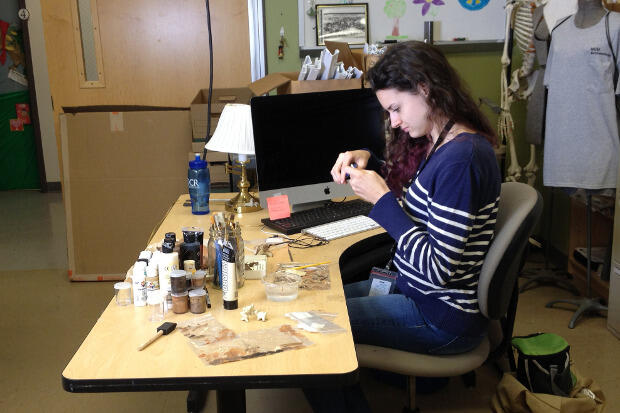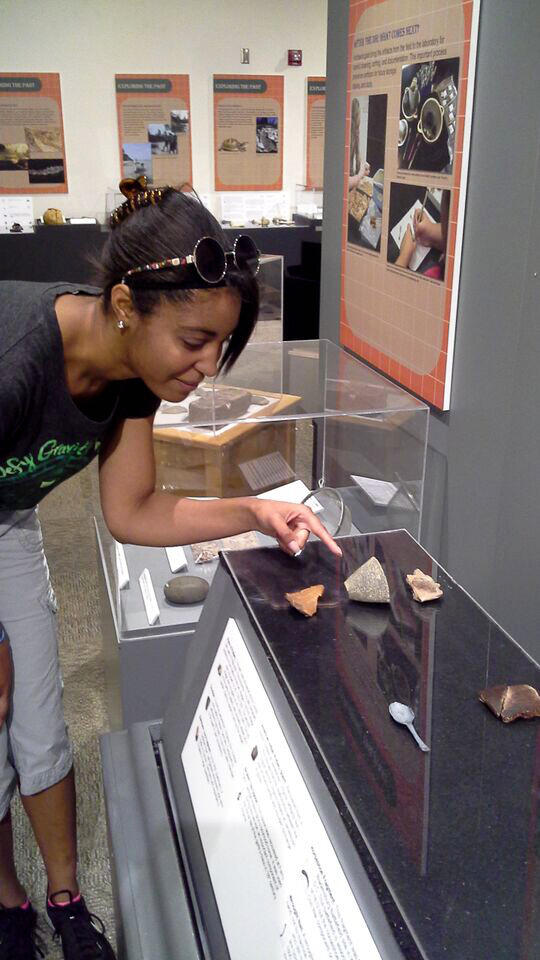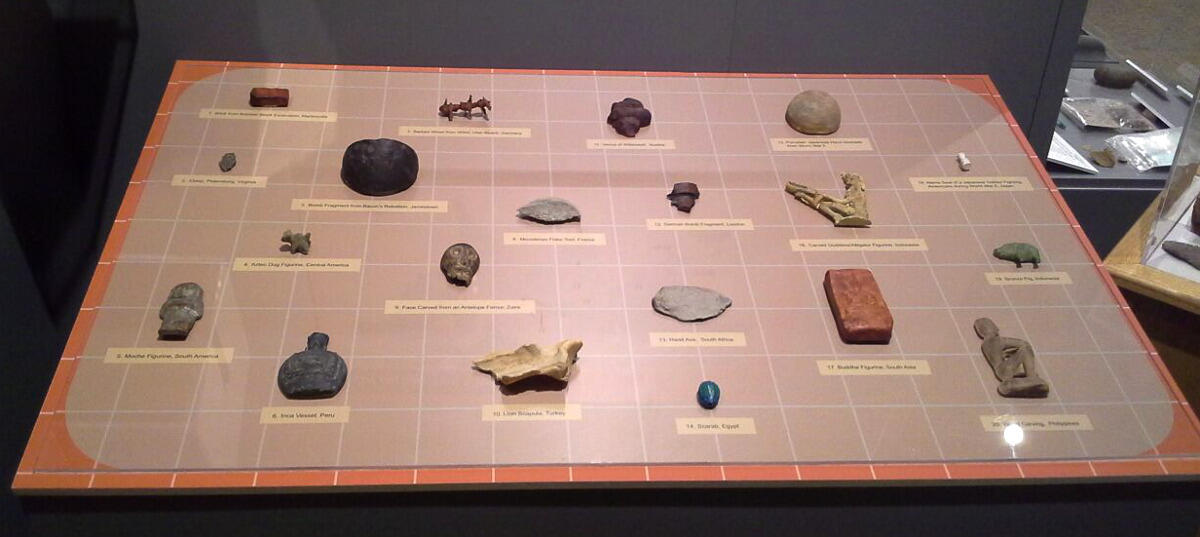
Oct. 1, 2015
At Virginia Museum of Natural History, students help design exhibit on Virginia exploration
Share this story
Anthropology students at Virginia Commonwealth University helped design a new exhibition at the Virginia Museum of Natural History that features more than 200 3-D-printed artifact replicas from sites such as George Washington’s Ferry Farm and Mount Vernon, James Madison’s Montpelier, Thomas Jefferson’s Poplar Forest, and Jamestown.
The exhibition, "Exploring Virginia," at the Martinsville museum, tells the story of how 17th-century explorers from England, Spain, France and Portugal explored the New World, while also demonstrating how scientists are exploring Virginia’s past today through archaeological research methods and technology.
The students worked on the exhibit as part of an assignment for their class, Visualizing and Exhibiting Anthropology, taught by Bernard Means, Ph.D., an anthropology professor in the School of World Studies in the College of Humanities and Sciences and director of VCU’s Virtual Curation Laboratory, which specializes in the 3-D scanning and printing of artifacts.
“The students in the Visualizing and Exhibiting Anthropology course not only designed the text and assembled images for over a dozen panels, but also selected over 200 objects for the various parts of the exhibit,” Means said. “These were then 3-D printed and painted, either by these students, or by interns in the Virtual Curation Laboratory — or, in some cases, by Dr. [Elizabeth] Moore [curator of archaeology at the museum] and her daughter during the summer leading up to the exhibit.”
Moore, who spoke to the class about the museum’s exhibit development process and the challenges associated with putting together an exhibit for visitors of all ages, said it was a joy to work with the VCU students on the exhibit.
“It is a challenge to go through the process of brainstorming lots of ideas, selecting only a few, then developing the content that can best convey those ideas,” she said. “It’s even more of a challenge doing this as part of a team where everyone has lots of ideas and is equally passionate. They rose to that challenge and did it successfully.”

She added that the students were “inquisitive and creative, and had a lot of ideas for content, interactives and exhibit-related activities.
“Their perspective and the way they became enthusiastic about ways to communicate the excitement of scientific discovery and interpretation was infectious.”
The "Exploring Virginia" exhibition has two parts, each showing a different aspect of Virginia exploration. First, it examines the physical exploration of Virginia, focusing on the stories of lesser-known figures from the European exploration of the region.
“Most people know the name John Smith but beyond him, they have little knowledge of the people who traveled throughout the region to report back on the Native Americans who had been living here for thousands of years, the natural resources present and the general topography,” Moore said. “Into the 1700s, many English thought that there was a sea just west of the mountains that would provide access to trade with China. Their surprise and dismay when they traveled west and saw that there was a lot more to the continent is reflected in their journals; we incorporate some of those passages in the exhibit and we use a series of historical maps to illustrate how the perception of the continent changed over time as our knowledge increased.”
Secondly, the exhibit shows how scientists today use modern technology, including the 3-D scanning and printing of artifacts from Virginia historical sites, to understand more about Virginia’s past associated with finding or growing food, belief systems, health and hygiene, personal expression and artistic expression.
“One of my favorite topics that the students developed is called ‘A Voice for the Voiceless’ and discusses how archaeology can be used to ensure that the people typically left out of historical narratives — women, slaves, Native Americans, children, religious minorities — have their stories told as well,” she said. “The students put together a powerful selection of artifacts that help us understand the lives of the people who are often left out of history.”
Brenna Geraghty, a senior anthropology major, worked on the exhibit as part of the class and then continued working on it as a summer intern at the museum.
“At the museum, I worked with Dr. Elizabeth Moore to visualize the layout of the exhibit in the exhibit hall. She and I met with the museum’s exhibit design team regularly to carry out and adapt our vision for the panels and interactives in a way that would be most appealing to visitors,” Geraghty said. “I also had the job of editing the text my class had come up with, as well as that from other parts of the larger exhibit.”
The ability to make physical contact with an object, even a replica of an object, can be powerful and provide a more meaningful connection to the past.
The biggest part of Geraghty’s work was painting the 3-D artifact replicas to look like the originals.
“Over the nine weeks I worked there, I painted around 90 replicas, roughly two-thirds of the 3-D prints now on display,” she said. “I love painting replicas, so I really enjoyed that part of the job. It was all a blast, though. The class was a great environment, like all Dr. Means’ classes, and getting to be a kind of liaison between our class and the museum was an amazing experience.”
By including a wide array of 3-D-printed artifact replicas, the museum was able to display artifacts not normally loaned out by their home institutions, and also provide visitors with the chance to touch and manipulate the replicas.
“The ability to make physical contact with an object, even a replica of an object, can be powerful and provide a more meaningful connection to the past,” Moore said. “A rusted and broken hoe blade may not be that interesting to look at, but when a visitor learns that this particular hoe is associated with one of the earliest slave contexts in Virginia and they can then touch that hoe replica it provides an immediate and physical connection to the past.”

Zoe Rahsman, a senior anthropology major, said the 3-D-printed replicas offer many educational benefits to the exhibit’s visitors.
“We initially chose artifacts that were available to be 3-D printed and incorporated into the exhibit design,” she said. “I think that they added a visual and tactile element to the exhibit that departed from the traditional ‘Look, don’t touch’ rule of museums.”
Hannah Lickey, a senior anthropology major, was among the several students who attended the exhibit’s opening. She said that 3-D printing was a big draw. “I think it adds an element of future and technology to a subject that people think as old and musty,” she said.
Rahsman said that much of the students’ work involved brainstorming exhibit panel themes and text that would engage visitors.
“It was surprisingly challenging to write a description that was both concise and readable. Additionally, we picked out artifacts that would complement our exhibit panels,” she said. “I enjoyed the flexible structure of the class that encouraged group work and allowed for this kind of creative process.”
Erica Michelle Eddins, a junior anthropology major, said she enjoyed working on the exhibit, though it was occasionally frustrating as the students sometimes struggled to find the right wording for exhibit text displays.
“I think the frustration made the experience feel more authentic and helped show me how much really goes into creating a museum exhibit,” she said. “I was very happy with the exhibit. There is nothing like seeing the final product of all of your work.”
She added that she is proud to have her work featured at the museum. “I hope that the exhibit allows visitors to walk out the door with something new to think about and makes them more aware of archaeology, Virginia history and 3-D printing,” she said.
Subscribe to the weekly VCU News email newsletter at http://newsletter.news.vcu.edu/ and receive a selection of stories, videos, photos, news clips and event listings in your inbox every Thursday.
Subscribe to VCU News
Subscribe to VCU News at newsletter.vcu.edu and receive a selection of stories, videos, photos, news clips and event listings in your inbox.






